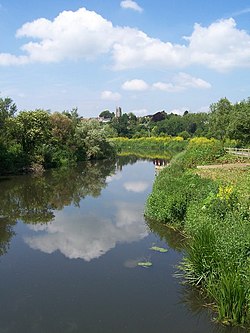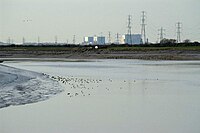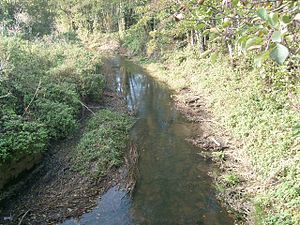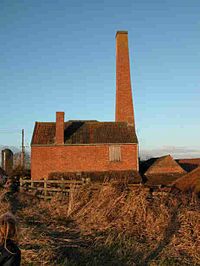River Parrett



The River Parrett is a famous river of Somerset, 37 miles long and flowing through both Somerset and Dorset, rising in the latter county.
The source of the Parrett is in the Thorney Mills springs in the hills around Chedington in Dorset. Flowing northwest through Somerset and the Somerset Levels to its mouth at Burnham-on-Sea, discharging into Bridgwater Bay on the Bristol Channel, the Parrett and its tributaries drain an area of 660 square miles – about 50% of Somerset's land area, with a population of 300,000.[1][2]
The Parrett's main tributaries include the Rivers Tone, Isle, and Yeo, and the River Cary by way of the King's Sedgemoor Drain. The river is tidal for 27 miles of its 37-mle length, as far up as Oath. In this flat landscape, the fall of the river between Langport and Bridgwater is only 1 foot per mile, which leaves it prone to frequent flooding in winter and during high tides. Many approaches have been tried since at least the mediæval period to reduce the incidence and effect of floods and to drain the surrounding fields.
Man's influence on the river has left a legacy of bridges and industrial artefacts. The Parrett along with its connected waterways and network of drains supports an ecosystem that includes several rare species of flora and fauna. The River Parrett Trail has been established along the banks of the river.
Name
The origin of the name Parrett is unclear, but several derivations from the ancient British languagehas been suggested.
- Pared: "partition" - Priestley-Evans suggests that "it was the name which the Welsh people of Somerset and Devon gave to that river because it was at one time the dividing line between themselves and the Saxons".[3] Another spelling parwydydd is also translated as partition.[4]
- Peraidd: "sweet or delicious river".[5]
- Pedair or Pedride: "Four streams", from the Old Cornish pedr (four) and Rit (flow).[6][7]
Whatever the derivation, the name Parrett and its spelling variations have been in use since the Anglo-Saxon era. It has given its name to the little local towns of North Petherton and South Petherton. The Oxford Dictionary of British Place Names states only that the name is a 'pre-English river-name of obscure origin'.[8]

Course
The River Parrett is 37 miles long, flowing roughly south to north from Dorset through Somerset. Its source is in the Thorney Mills springs in the hills around Chedington, 2½ miles from the source of the River Axe, which runs in the opposite direction to the English Channel at Axmouth.
From its source, the Parrett runs north to South Perrott and due north, forming the county border for something over half a mile before fully entering Somerset.
It flows through the fields to the west of North Perrott (at the foot of Perrott Hill School) and in a little valley between the higher grounds of Crewcerne to the west and North Perrott and Haselbury Plucknett to the east.[9]
Through no villages, it passes close by Merriott to the west and West Chinnock and Chiselborough to the east, then under the A303 trunk road to the east of South Petherton, between East Lambrook and Bower Hinton west of Martock and then towards Kingsbury Episcopi.
Not a single village lies on the banks of the Parrett in its whole course until it scrapes the edge of Kingsbury Episcopi, but only at the tiny village of Thorney is a village on its banks and bridging it, and there the Parrett has entered upon the broad, flat lands of the Somerset Levels, where the villages stand on higher ground away from potentially flooding rivers. Below Thorney Bridge the river's banks have been raised to mitigate flooding.[9] The Parrett flows past Muchelney to the east, passing the remains of Muchelney Abbey then comes to Langport, which is about 10 miles north of Chiselborough. At Langport there are wharves on the river.

The Parrett flows northwest from Langport for another 10 miles to Bridgwater through the Somerset Levels past Aller, and at the deserted mediæval village, and modern hamlet, of Oath the Parret becomes tidal, at Oath Lock.
The tidal river then crosses Southlake Moor and on to Burrow Mump, an ancient earthwork owned by the National Trust.[10] The river then arrives in Burrowbridge, where the old pumping station building was once a museum[10] and north past the land-drainage pumping station at Westonzoyland.[11]
Further downstream the river passes the village of Huntworth before flowing under the M5 motorway at Dunwear. As it enters Bridgwater it passes under Somerset and Hamp Bridges, and past Bridgwater Castle which had a tidal moat up to 65 feet wide in places, fed by water from the river.[12] From Bridgwater to the sea is approximately 6 miles. The King's Sedgemoor Drain drains into the River Parrett next to the wharf at Dunball; it enters by way of a clyce (or clyse), which is a local word for a sluice. The clyce has been taken about a third of a mile downstream from its original position and now obstructs the entrance to the small harbour next to the wharf.[13]

The course of the river below Bridgwater is now somewhat straighter than in former times. The village of Combwich lies adjacent to a channel in the river known as "Combwich Reach"; from here the Parrett flows to the Bristol Channel past the Steart Peninsula.
The mouth at Burnham-on-Sea is a nature reserve where the river flows into Bridgwater Bay on the Bristol Channel. In addition to the rivers Parrett, Brue and Washford, several of the man-made drainage ditches, including the River Huntspill from the Somerset Levels, and the Cannington Brook from the "Pawlett Hams", also discharge into the bay.
Tidal bore
The rate and direction of flow of the Parrett is dependent on the state of the tide on the River Severn. In common with the lower reaches of the River Severn, the Parrett experiences a tidal bore. Certain combinations of the tides funnel the rising water into a wave that travels upstream at about 6 mph, against the river's current.[14]
Historical interest
It is reckoned that for a century or so in the Dark Ages, the river formed a boundary between the West Saxons and the Britons of Dumnonia. It later served the Port of Bridgwater, and enabled cargoes to be transported inland. The arrival of the railways led to a decline in commercial shipping and the only working docks are at Dunball.

The River Parrett, the Bristol Channel and the Severn Estuary are believed to have been used for riverine bulk transportation of people and supplies in Somerset under Roman and later Anglo-Saxon and Norman occupation.[15] There is evidence of two Roman ports on the Parrett. The port at Combwich, on the west bank, was ill-recorded before its destruction by quarrying and erosion. The other at Crandon Bridge on the east bank near where the current King's Sedgemoor Drain enters the Parrett,[16][17] was in use between the first and the fourth centuries.[18] Evidence of an extensive site with storehouses was found in the mid-1970s, during motorway construction works.[16] The Crandon Bridge site may have been linked by a probable Roman road over the Polden Hills to the Fosse Way, at Ilchester.[16][18][19] Ilchester, the largest Roman town in Somerset, was a port with large granaries, sited where the Fosse Way crossed the Ilchester Yeo by means of a paved ford.[20] The Yeo was navigable by small craft all the way to the Parrett allowing military supplies to be brought by boat directly to Ilchester; however, disembarkation at Crandon Bridge and use of the Polden Hills roadway allowed more rapid movement to Ilchester. The Yeo may already have been straightened and canalised before Roman occupation.[19]
The Parrett was established as the border between the English kingdom of Wessex and the British kingdom of Dumnonia in 658, following the Britons' defeat at the Battle of Peonnum that year.[21][22] This natural border may have endured for almost a century until further fighting between the English and Britons in the mid-8th century.
In the 15th century the ferry over the Parrett at Combwich was regarded as part of the King's Highway; and both passengers and cattle were carried in the 16th and 17th centuries.[23] Records of the joint Manorial ownership and costs of the ferry exist for 1589 and 1810.[23] The White House Inn, a licensed victualler and part-owner of the ferry, traded on the Pawlett bank from 1655 to 1897; and the building was retained as a farm dwelling for another 20 years.[23] The Combwich river crossing, which was a main route until the 18th century, fell out of use due to turnpike trusts improving what were to become the A38 and A39 roads, and traffic went via Bridgwater; the former inn was demolished c. 1930.[23][24]

Continuing land reclamation and control of the Parrett was a long-running cycle of neglect followed by improvement. Work was carried out on the upper River Parrett basin in the mediæval period by Glastonbury Abbey.[25] Abbot Michael's survey of 1234 showed 722 acres of meadow recovered around the "island" of Sowy; and, from the accounts in the Abbey's rent books, this had increased to 972 acres by 1240.[25] Flooding of adjacent moor land was partially addressed in the 13th century by building a number of embankment walls to contain the Parrett. These included Southlake Wall, Burrow Wall and Lake Wall.[25] The River Tone was also diverted by the Abbot of Athelney, and other land owners, into a new embanked channel, joining the Parrett upstream from its original confluence.[19][25] After the Dissolution of the Monasteries, in the 16th century, much of the former abbey lands came under the control of the Crown, particularly King's Sedgemoor which had been wholly owned by Glastonbury Abbey, and the King's "Courts of Sewers" was made responsible for maintaining existing drainage. Further reclamation work was carried out over the next 500 years. In 1597, 50 acres of land were recovered near the Parrett estuary; a few years later 140 acres near Pawlett were recovered by means of embankments; and three further reclamations, totalling 110 acres, were undertaken downstream of Bridgwater by 1660.[26] Kings James I, Charles I and Charles II continued to improve King's Sedgemoor.[26]

The town of Bridgwater was founded as a new borough about 1200; it had a castle and a market and became a port in its own right.[27] It was the major port for Somerset which, around the Quantocks, the Brendon Hills and the Tone valley, was mainly agricultural, producing crops to supply the new industrial towns.[28] Combwich was the traditional River Parrett pilots' harbour from at least the 14th century.[27][29] It also served as a port for the export of local produce and, from the 15th century, the import of timber. Until the late 1930s, when the creek silted up, coastal shipping served Combwich's local brick and coal yard.[30]
In the Middle Ages the river was busy with barges bringing stone fom the quarry at Ham Hill for building churches throughout the county.[31] Later, in the 19th century, coal from across the Bristol Channel, for heating, Bath bricks, bricks and tiles would be carried.[32] Brick making, which had been carried out intermittently in Bridgwater from the 17th century, by the late 18th century had expanded into an industry based on permanent brickyards in the Bridgwater area adjacent to the Parrett.[33]
The famous Bath brick was made from the alluvial mud of the river and exported from here.
Port of Bridgwater

Bridgwater was part of the Port of Bristol until the Port of Bridgwater was created in 1348, covering {{convert|80 miles of the Somerset coast line, from the Devon border to the mouth of the River Axe.[34][35] Under an 1845 Act of Parliament the Port of Bridgwater extends from Brean Down to Hinkley Point in Bridgwater Bay, and includes parts of the River Parrett (to Bridgwater), River Brue and the River Axe.
Historically, the main port on the river was at Bridgwater, where a span crossed the river from 1200 AD onwards.[36] Quays were built at Bridgwater in 1424; with another quay, the Langport slip, being built in 1488 upstream of the Town Bridge.[36] A Customs House was sited at Bridgwater, on West Quay; and a dry dock, launching slips and a boat yard on East Quay.[37][38] Bridgwater also built some 167 ships; the last one being the Irene launched in 1907.[38]
The river was navigable, with care, to Bridgwater Town Bridge by 400-500 ton vessels.[39] By trans-shipping goods into barges at the Town Bridge the Parrett was navigable as far as Langport and (via the River Yeo) to Ilchester. After 1827, it was also possible to transport goods to Taunton by way of the Bridgwater and Taunton Canal at Huntworth.
Shipping to Bridgwater expanded with the construction of the docks, which opened on 25 March 1841,[40] and reached a peak in the 19th century between 1880 and 1885; with an average of 3,600 ships per year entering the port.[41] Peak tonnage occurred in 1857, with 142 vessels totalling 17,800 tons.[42] In the short term, the opening of the docks increased the profitability of the Bridgwater and Taunton Canal, which peaked in 1847 at 88,000 tons of cargo. By the mid-1850s though the canal was bankrupt due to competition from the railways.
Sedgemoor District Council acts as the Competent Harbour Authority for the port, and provides pilotage services for all boats over 98 feet; is important because of the constant changes in the navigable channel. Most commercial shipping travels upriver as far as Dunball wharf, which handles bulk cargoes.
Nature

The river flows through several areas of ecological interest and supports a variety of rare and endangered species.
From January until May, the Parrett provides a source of eels (Anguilla anguilla) and young elvers, which are caught by hand netting as this is the only legal means of catching them.[43] A series of eel passes have been built on the Parrett at the King's Sedgemoor Drain to help this endangered species; cameras have shown 10,000 eels migrating upstream in a single night.[44]
Southlake Moor by the river is one of several SSSIs hereabouts. It forms part of an extensive grazing marsh and ditch system. When conditions in the River Parrett are suitable, the moor can be deliberately flooded in winter by opening a sluice in the river's floodbank. Some 96 species of aquatic and bankside vascular plant species have been recorded on Southlake Moor and when the moor is flooded it can be occupied by large numbers of wildfowl; up to 22,000 Wigeon (Anas penelope), 250 Bewick's Swan (Cygnus bewickii) and good numbers of Pochard (Aythya ferina), Teal (Anas crecca) and Tufted Duck (Aythya fuligula). Otter spraint is regularly seen on the muddy banks of the River Parrett.

The Parrett flows through the Somerset Levels, which contain a rich biodiversity of national and international importance.
Visitors

River Parrett Trail runs for 47 miles following the Parrett from its source to the sea. The river passes many landmarks and places of interest including: Burrow Hill Cider Farm, Muchelney Abbey, West Sedgemoor, the Blake Museum, Westonzoyland Pumping Station Museum, the site of the Battle of Sedgemoor and finally discharging into Bridgwater Bay.[9]
The Langport and River Parrett Visitor Centre located at Langport details local life, history and wildlife.
References
- ↑ Nursey, Keith (1 December 2009). "Parrett Catchment Flood Management Plan" (PDF). Environment Agency. p. 13. http://publications.environment-agency.gov.uk/PDF/GESW1109BOUT-E-E.pdf. Retrieved 2 January 2010.
- ↑ Thomas, H.; T. R. Nisbet (2007). "An assessment of the impact of floodplain woodland on flood flows". Water and Environment Journal 21 (2): 114–126. doi:10.1111/j.1747-6593.2006.00056.x. http://www.blackwell-synergy.com/doi/pdf/10.1111/j.1747-6593.2006.00056.x. Retrieved 22 November 2007.
- ↑ Priestley Evans 1931, p. 6
- ↑ "Department of Welsh". University of Wales, Lampeter. http://www.geiriadur.net/index.php?page=ateb&term=parwydydd&direction=we&type=all&whichpart=exact. Retrieved 4 May 2010.
- ↑ Arthur 1857, p. 213
- ↑ Crowden 1996, p. 133
- ↑ Ekwall 1928, pp. 320–322
- ↑ A Dictionary of British Place-Names, Revised Edition, editor David Mills, ISBN 978-0-19-960908-6
- ↑ 9.0 9.1 9.2 The River Parrett Trail – Following a river from source to mouth, (1997), Tourism and Marketing Unit, South Somerset District Council
- ↑ 10.0 10.1 Leete-Hodge 1985, p. 82
- ↑ "The Westonzoyland Pumping Station". Westonzoyland pumping station. http://www.wzlet.org/index.htm. Retrieved 11 November 2010.
- ↑ "Bridgwater Castle". Bridgwater.net. http://www.bridgwater.net/Town/About_Town/History/bridgwater_castle.htm. Retrieved 12 October 2008.
- ↑ Otter 1994, pp. 94–100
- ↑ Evans, Roger. The Docks. Bridgwater Somerset.info. ISBN 0-907768-76-8. http://www.bridgwatersomerset.info/history_5_the_docks.php. Retrieved 1 February 2009.
- ↑ Leach 2001, pp. 73–83
- ↑ 16.0 16.1 16.2 Rippon 1997, pp. 53–55
- ↑ Rippon 2007, pp. 207–227
- ↑ 18.0 18.1 Dunning 1992, p. 183
- ↑ 19.0 19.1 19.2 Hollinrake & Hollinrake 2007, pp. 228–234
- ↑ Dunning 1974, pp. 179–203
- ↑ Stenton 1971, p. 63
- ↑ Hawkins 1982, p. 36
- ↑ 23.0 23.1 23.2 23.3 Dunning 1992, pp. 267–268
- ↑ Fitzhugh 1993, p. 69
- ↑ 25.0 25.1 25.2 25.3 Williams 1970, pp. 25–81
- ↑ 26.0 26.1 Williams 1970, pp. 82–122
- ↑ 27.0 27.1 Rippon 1997, pp. 234–237
- ↑ Hussey 2000, pp. 4–5
- ↑ Hussey 2000, p. 10
- ↑ Farr 1954, pp. 117–118
- ↑ Gerrard, Christopher M. (1985). "Ham Hill Stone: A mediæval distribution pattern from Somerset". Oxford Journal of Archaeology 4 (1): 105–116. doi:10.1111/j.1468-0092.1985.tb00234.x.
- ↑ Farr 1954, pp. 111–112
- ↑ Murless 2000, pp. 5–13
- ↑ Lawrence, J.F. (revised and completed by Lawrence, J.C.) (2005). A History of Bridgwater. Chichester: Phillimore. ISBN 1-86077-363-X. Chapter 8: "The Mediæval Port of Bridgwater".
- ↑ Farr 1954, p. 104
- ↑ 36.0 36.1 Dunning 1992, p. 193
- ↑ Farr 1954, p. 102
- ↑ 38.0 38.1 Farr 1954, p. 113
- ↑ Fitzhugh 1993, pp. 6–7
- ↑ Farr 1954, p. 110
- ↑ Lawrence, J.F. (revised and completed by Lawrence, J.C.) (2005). A History of Bridgwater. Chichester: Phillimore. ISBN 1-86077-363-X. Chapter 21: "Victorian Times".
- ↑ Farr 1954, p. 109
- ↑ "Environment Agency Eel and Elver Fishing Guidance". Environment Agency. Archived from the original on 8 January 2010. http://www.efishbusiness.co.uk/formsandguides/eel-elver-guidance.pdf. Retrieved 22 December 2009.
- ↑ "Groundbreaking project saves glass eels". Nature Features. BBC Somerset. 4 September 2008. http://www.bbc.co.uk/somerset/content/articles/2008/09/03/eels_feature.shtml. Retrieved 21 December 2009.
Books
- Arthur, William (1857) (text). An etymological dictionary of family and Christian names. With an essay on their derivation and import. New York: Sheldon, Blakeman & Co. http://www.archive.org/stream/etymologicaldict00arthuoft/etymologicaldict00arthuoft_djvu.txt. Retrieved 3 June 2010.
- Blair, John (ed.) (2007). Waterways and Canal-Building in Mediæval England. Mediæval History and Archaeology. Oxford: Oxford University Press. ISBN 978-0-19-921715-1.
- Body, Geoffrey; Gallop, Roy (2006). Parrett River Trade. Bristol: Fiducia Press. ISBN 978-0-946217-25-0.
- Bush, Robin (1994). Somerset: The complete guide. Wimborne, Dorset: Dovecote Press. ISBN 1-874336-27-X.
- Costen, Michael (1992). "The late Saxon Landscape". in Michael Aston. Aspects of the Mediæval Landscape of Somerset. Taunton: Somerset Books. ISBN 978-0-86183-129-6.
- Crowden, James (1996). In Time of Flood: The Somerset Levels-The River Parrett. George Wright (Photographer). Yeovil: The Parrett trail Partnership. ISBN 1-899983-25-2.
- Dunning, R. W. (1974). The histories of the parishes of Kingsbury (east), Pitney, Somerton and Tintinhull hundreds. The Victoria History of the County of Somerset. III. Oxford: Victoria County History. ISBN 0-19-722739-2. http://www.british-history.ac.uk/source.aspx?pubid=545.
- Dunning, R. W. (ed.) (1992). Andersfield, Cannington, and North Petherton Hundreds (Bridgwater and Neighbouring Parishes). The Victoria History of the County of Somerset. VI. Oxford: Oxford University Press for the University of London Institute of Historical Research. ISBN 0-19-722780-5.
- Dunning, Robert (1992b). Bridgwater: History and Guide. Stroud: Alan Sutton. ISBN 0-7509-0192-6.
- Dunning, Robert (2002). A history of Somerset (3rd ed.). Tiverton: Somerset County Library. ISBN 0-86183-476-3.
- Ekwall, Eilert (1928). English River Names. Oxford Clarendon Press.
- Farr, Grahame (1954). Somerset Harbours. London: Christopher Johnson. ISBN 0-900131-15-2.
- Fitzhugh, Rod (1993). Bridgwater and the River Parrett: in old photographs. Stroud: Alan Sutton Publishing. ISBN 0-7509-0518-2.
- Hadfield, Charles (1967). The Canals of South West England. Newton Abbot: David and Charles. ISBN 978-0-7153-4176-6.
- Hannah, Leslie (1982). Engineers, Managers, and Politicians: The First Fifteen Years of the Nationalised Electricity Supply in Britain. Baltimore: The Johns Hopkins University Press. ISBN 0-8018-2862-7.
- Haskell, Tony (2007). By Waterway to Taunton: The Bridgwater and Taunton Canal. Stroud: Tempus Publishing. ISBN 978-0-7524-4267-9.
- Havinden, Michael (1982). The Somerset Landscape. The making of the English landscape. London: Hodder and Stoughton. ISBN 0-340-20116-9.
- Hawkins, Desmond (1982). Avalon and Sedgemoor. Gloucester: Alan Sutton Publishing. ISBN 978-0-86299-016-9.
- Hollinrake, Charles; Hollinrake, Nancy (2007). "Chapter 9: The Water Roads of Somerset". in Blair, John. Waterways and Canal-Building in Mediæval England. Oxford: Oxford University Press. ISBN 978-0-19-921715-1.
- Hussey, David (2000). Coastal and River Trade in Pre-Industrial England: Bristol and Its Region 1680–1730. Ithaca, New York: Regatta Press. ISBN 0-9674826-4-X.
- Lawrence, J.F.; revised and completed by Lawrence, J.C. (2005). A History of Bridgwater. Chichester: Phillimore. ISBN 1-86077-363-X.
- Leach, Peter (2001). Roman Somerset. Wimborne: The Dovecot Press. ISBN 978-1-874336-93-8.
- Leete-Hodge, Lornie (1985). Curiosities of Somerset. Bodmin: Bossiney Books. ISBN 0-906456-98-3.
- MacDermot, E.T. (1931). History of the Great Western Railway, vol. II: 1863–1921. Paddington: Great Western Railway.
- Marsh, Terry; Hannaford, Jamie, eds (2008). UK Hydrographic Register. Hydrological data UK series. Wallingford, Oxfordshire: Centre for Ecology & Hydrology. ISBN 978-0-9557672-2-7. http://www.ceh.ac.uk/products/publications/documents/HydrometricRegister_Final_WithCovers.pdf.
- Mills, A. D. (1998). Oxford Dictionary of English Place Names (Second ed.). Oxford: Oxford University Press. ISBN 0-19-280074-4.
- Murless, Brian J (2000). Somerset Brick & Tile Manufacturers: A Brief History & Gazetteer. SIAS Survey no. 13. Taunton: The Somerset Industrial Archaeological Society. ISBN 0-9533539-2-3.
- Oakley, Mike (2002). Somerset Railway Stations. Stanbridge: Dovecote Press. ISBN 978-1-904349-09-9.
- Taunton & Lyme Regis 193. OS Landranger Map. Ordnance Survey. 2008. ISBN 978-0-319-23140-1. http://leisure.ordnancesurvey.co.uk/products/paper-maps/paper-maps-ordnance-survey-great-britain/paper-maps-ordnance-survey-great-britain-os-landranger-map/taunton-and-lyme-regis/pid-9780319231401.
- "Bridgwater and Taunton Canal". No 7: River Thames and the southern waterways. OS-Nicholson Guide to the Waterways (2nd ed.). London: Harper Collins. 2003. ISBN 978-0-00-713670-4.
- Otter, R. A. (1994). Civil Engineering Heritage: Southern England. London: Thomas Telford. ISBN 0-7277-1971-8.
- Page, William, ed (1906). "Romano-British Somerset". Victoria History of the Counties of England vol 1.. London: Archibald Constable & Co.
- Priestley, Joseph (1969). Historical Account of the Navigable Rivers, Canals, and Railways, of Great Britain (2nd ed.). Newton Abbot: David & Charles. ISBN 0-7153-4395-5. http://www.jim-shead.com/waterways/sdoc.php?wpage=PNRC0001.
- Priestley Evans, Evan David (1931). Two papers : entitled "The Severn and other Wye Rivers" and "The Meaning of Minster in place names" read at meetings of the Philological Society on Friday, 2 November 1928, and on Friday, 28 October 1927, respectively), with an additional chapter on "Conjectural meanings of the individual Minster place names" and notes on both papers. Hereford: Stephen Austin. http://books.google.com/?id=Do52n_1KEYAC&cd=4&dq=The+Meaning+of+Severn%2C+Ouse%2C+Minster%2C+etc.&q=parrett#search_anchor.
- Rippon, Stephen (1997). The Severn Estuary: Landscape Evolution and Wetland Reclamation. London: Leicester University Press. ISBN 978-0-7185-0069-6.
- Rippon, Stephen (2007). "Chapter 8: Waterways and Water Transport on Reclaimed Coastal Marshlands: The Somerset Levels and Beyond". in Blair, John. Waterways and Canal-Building in Mediæval England. Oxford: Oxford University Press. ISBN 978-0-19-921715-1.
- Robinson, Stephen (1992). Somerset Place Names. Wimborne: Dovecote Press. ISBN 1-874336-03-2.
- Russell, Ronald (1971). Lost Canals of England and Wales. Newton Abbot: David & Charles. ISBN 0-7153-5417-5.
- Stenton, Frank (1971). Anglo-Saxon England (3rd ed.). Oxford: Oxford University Press. ISBN 978-0-19-280139-5.
- Stubbs, Alan; Drake, Martin (2001). British Soldierflies and Their Allies: A Field Guide to the Larger British Brachycera. Reading: British Entomological & Natural History Society. ISBN 978-1-899935-04-8.
- Waite, Vincent (1964). Portrait of the Quantocks. London: Robert Hale. ISBN 0-7091-1158-4.
- Williams, Michael (1970). The Draining of the Somerset Levels. Cambridge: Cambridge University Press. ISBN 0-521-07486-X.